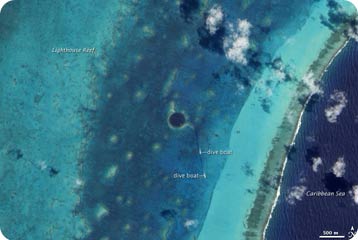Most of us have little trouble naming the world’s largest coral reef system. It’s Australia’s Great Barrier Reef -- 1600 miles of coral, aquamarine waters, and other natural wonders.
The second-largest reef system is no less wondrous. But it’s pretty much anonymous, even though it’s not that far from home.
 Aerial image of the Belize Barrier Reef. Credit: NASA
Aerial image of the Belize Barrier Reef. Credit: NASAThe Belize Barrier Reef stretches about 200 miles along the coast of Belize, on the Caribbean Sea. It’s a chain of scores of individual reefs and coral islands. Its northern end is just a few hundred yards from shore, while the southern end extends about 25 miles into the Caribbean.
The reefs and islands host a rich diversity of life: 65 species of hard coral, more than 500 species of fish, and 350 species of mollusks. Gulls, boobies, frigate birds, and brown pelicans are common, and so are loggerhead and hawksbill sea turtles. And the reef is home to the world’s largest population of West Indian manatees.
The reef system is drawing more tourists to Belize. So far, that hasn’t hurt the delicate reefs. But there’s concern that global climate change could. The reefs suffered a “bleaching” episode in the 1990s, in which the corals expelled the microscopic organisms that live within them and give them their color -- perhaps as a result of warmer water temperatures. The weakened reef system was then severely damaged by a hurricane.
Even so, the Belize Barrier Reef remains one of the great wonders of the sea -- even if few people have ever heard of it.

